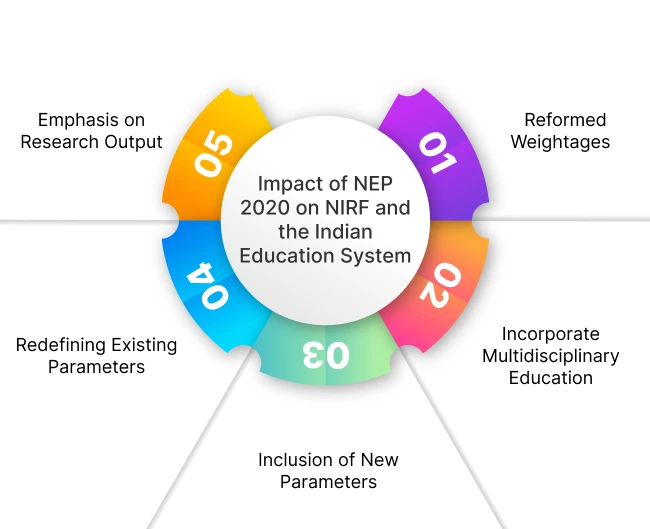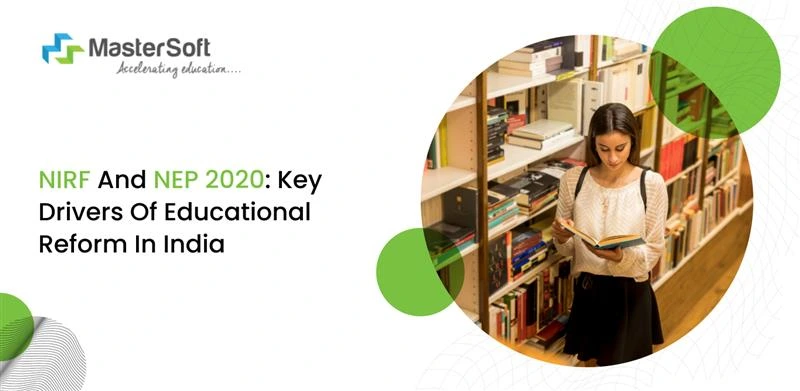20, Jan 2025
‘’Top engineering colleges in India’’ or ‘’The best colleges that provide 100 percent placement assistance’’ are examples of keywords that students use to search for their ideal institutes. However, online resources and word of mouth are hardly sufficient when selecting a college or university; that is where NIRF comes in.
NIRF has played a significant role in the last few years by fostering a sense of healthy competition between HEIs. It has encouraged institutes to improve their core operation, and the NEP 2020 has emphasised reforming a few key areas, making the rankings more nuanced. Let us take a look at NIRF and how NEP 2020 impacts the ranking framework:
NIRF (National Institutional Ranking Framework)
NIRF, or the National Institutional Ranking Framework, is a ranking methodology that the Ministry of Education, Government of India, developed. It is a systematic procedure that ranks or categorises institutes depending on their programs/courses.
The programs cover a wide array of disciplines, including engineering, architecture, medicine, pharmacy, management, law, dentistry, and agriculture. The ranking procedure relies on five crucial parameters:
- Teaching, Learning, and Resources (TLR)
- Research and Professional Practice (RP)
- Graduation Outcomes (GO)
- Outreach and Inclusivity (OI)
- Perception (P)
The parameters are almost the same for different kinds of institutes; however, the assigned weightage differs, depending on the particular category of the institute that participates in the ranking process.
Such uneven categorisation will undergo a major shift due to NEP 2020, which highlights the need to establish multidisciplinary education. Furthermore, it lays special emphasis on research activities and creating integrated universities that break down silos among various areas of study.

Impact of NEP 2020 on NIRF and the Indian Education System
The Ministry of Education, formerly the Ministry of Human Resource and Development (MHRD), launched NIRF in September 2015. The ranking framework has evolved into a significant quality assurance mechanism over the years.
The National Education Policy 2020 envisions a comprehensive education system by classifying higher education institutes in India into three distinct categories:
- Research Universities
- Teaching Universities
- Autonomous degree-granting colleges
In order to align with the vision of NEP 2020, NIRF must make essential changes to its methodology. For instance, it needs to shift from ownership and program-based classification and incorporate NEP-defined categories. Some of the other notable changes are as follows:
1. Reformed Weightages
The policy focuses on research, multidisciplinary education, and hands-on learning; therefore, the NIRF weightages must adapt accordingly. Research universities can get 60 percent weightage for research and professional activities, whereas teaching, learning, and resources can get 20 percent.
On the other hand, teaching, teaching universities would emphasise teaching, learning, and resources with a 45 percent weightage. Graduation outcomes can have 25 percent weightage and 15 percent each for outreach and research.
Finally, the autonomous degree-granting colleges will focus on teaching, which will have a 45 percent weightage and a 30 percent weightage for graduation outcomes. Additionally, it will have a 20 percent weightage at outreach and a 5 percent weightage at research. This reformed weighting system will help align rankings with each higher education institute’s significant vision and mission as per NEP.
NEP 2024: The Updates in NEP 2020 Explained
2. Incorporate Multidisciplinary Education
Incorporating new parameters to assess the institute’s commitment to delivering high-quality and comprehensive education is noteworthy. Multi-disciplinary education is one of the primary components of the policy that HEIs have already started implementing in their curriculum.
Assigning scores based on the extent to which institutes facilitate holistic education will be central to the parameter. The policy focuses not just on the academic teaching and learning but also on the social, emotional, physical, and intellectual development.
Institutes and educators will encourage learners to apply their knowledge to relate to real-world issues and develop relevant solutions. In effect, it will help to foster critical thinking and analytical thinking abilities.
3. Inclusion of New Parameters
NIRF will introduce a new category that is aligned with the United Nations Sustainable Development Goals (SDGs) in the 2025 rankings. This is a strategic step towards establishing an environmentally friendly or conscious education.
NIRF may assign weightages on some of the categories such as:
Green Campus InitiativesIt will evaluate an institute’s eco-friendly practices and infrastructure on campus and the percentage of campus area under vegetation. Furthermore, it will assess the percentage of carbon footprint reduction.
Research and InnovationThe ranking framework will equally focus on institutes’ academic and industry efforts for sustainability through research publications. For instance, it will check the number of published papers related to sustainability in indexed journals.
Moreover, it emphasises MOUs (Memorandums of Understanding) with varied industries and organisations for research work and projects on sustainability.
Curricular and Co-curricular ContributionsNIRF highlights the integration of sustainability into education and extracurricular activities, wherein elective courses can focus on energy efficiency, climate change, etc. Also, it will assess the number of student-led green projects and documentation indicating an institute’s participation in international green challenges.
National Institutional Ranking Framework (NIRF): A Comprehensive Overview
4. Redefining Existing Parameters
The gradual alignment with NEP 2020’s vision requires the ranking framework to redefine its existing parameters such as ‘’Teaching, Learning, and Resources’’. Institutes and teachers will be required to maximise the use of innovative pedagogical strategies in the classroom.
Appropriate use of technological solutions like the learning management system will be central to the parameter. In effect, it will help to expand the scope of the parameter and enhance students’ learning experience in the long run.
What’s more, the parameter will also assess teachers using varied mechanisms to go beyond academic learning and include experiential activities. Furthermore, it will assess if the in-class activities lead to the student’s skill enhancement.
5. Emphasis on Research Output
The revised NIRF ranking framework focuses significantly on the research output, which would explain the increased weightage. Besides, research universities play an integral role in driving innovation and development, creating innovative solutions, and leading to societal progress.
Besides, NIRF aims to encourage HEIs to diversify their research and development activities, helping to attract highly qualified stakeholders (faculty, research scholars, and students). Furthermore, it promotes international collaborations, enabling HEIs to work with the world’s leading organisations on critical issues.
Also, an institute’s research output allows NIRF to assess the institute’s academic performance effectively compared to others. Consequently, it helps to identify various problem areas as well as crucial research contributions.
Conclusion
The National Institutional Ranking Framework is a significant ranking mechanism that functions as a quality assurance and evaluation system of the Indian education system. However, NEP 2020 has introduced transformative changes, and the NIRF must adapt accordingly by incorporating necessary provisions. From shifting to NEP-defined categories and redefining appropriate weightage, the framework will implement specific initiatives.
Still wondering how NEP 2024 will revolutionise the Indian education system?
Mobile: 08448010216
Email: janki.somani@iitms.co.in












